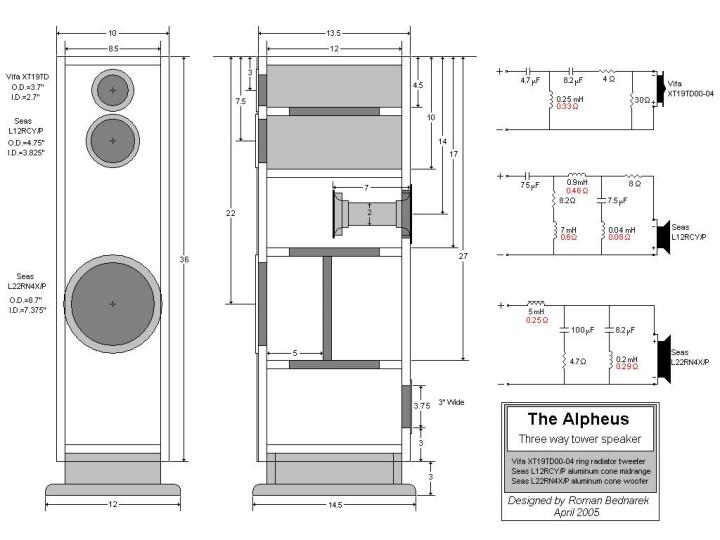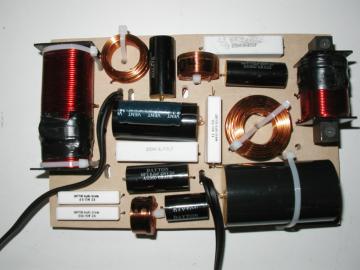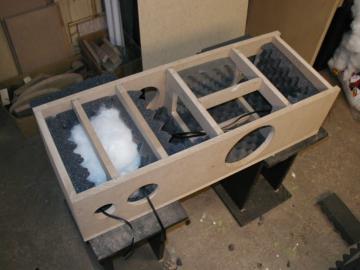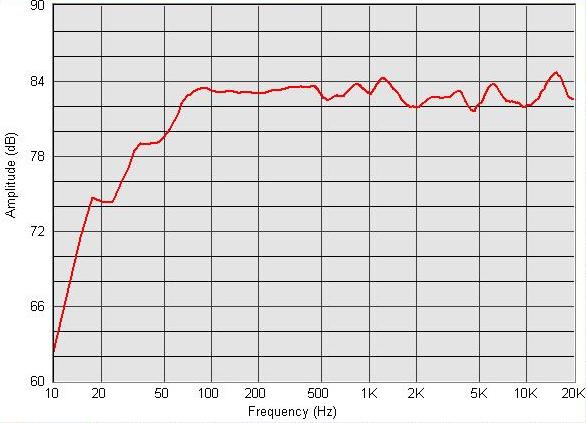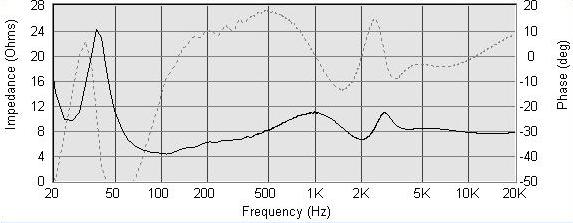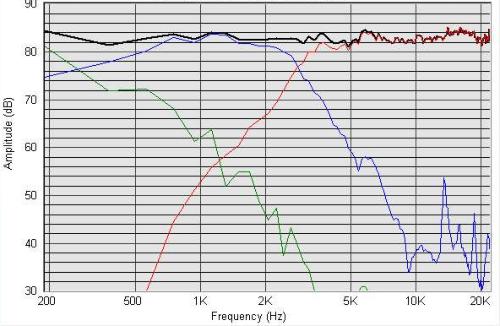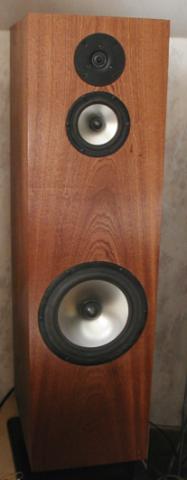Project writeup is based on use of faulty tweeters used during crossover design. Go here for details.
Considering that the midrange for the Alpheus MkII design is no longer in production while the Seas L12 is (thanks to an email reminder/recommendation
from a fellow DIY'er) I decided to put the original Alpheus design back online. Keep in mind that all of the work done below was done with the faulty, "buzzing",
tweeters installed so I don't have a very good idea of how the speakers might sound with non-faulty tweeters or if additional crossover tweaking might be
required. However, I do have enough confidence to say that my crossover is, in the least, a great starting point and may not require any additional tweaking at all.
Regardless, if you do decide to adjust the crossover to suit your tastes and/or room then I strongly recommend that you learn how to use Speaker Workshop (see my tutorial
under the "Audiofiles" section here... Using Speaker Workshop to simulate crossovers) and download
the Speaker Workshop project file below to be used as a guide for determining which components to adjust in order to boost or cut specific frequency ranges.
Introduction
The Alpheus is a floorstanding 3 way speaker using the Seas L22RN4X/P 8" aluminum woofer, Seas L12RCY/P 4.5" aluminum midrange and Vifa
XT19TD00-04 3/4" ring radiator tweeter. The Alpheus was my first attempt at designing a three way speaker and in the end I would have to say that
I was successful but it does help to have some nice drivers to work with. This design isn't super efficient but the bass response is very good, easily below 30Hz.
The amount of detail provided by these speakers is amazing and they have a very balanced frequency response. They are among the
best, if not the best, sounding speakers that I've designed up to this point.
Drivers
Vifa XT19TD00-04 3/4" dual concentric ring radiator fabric dome tweeter
This superb 3/4" tweeter features a patented dual concentric diaphragm and a unique wave guide center plug which provides excellent on and
off axis response. The smaller voice coil diameter takes the dual concentric concept even further, providing even greater high frequency
extension and off-axis performance. Unshielded variety; recommended for high crossover points.
Seas L12RCY/P (H1207) 4.5" aluminum midrange
The L12RCY/P is a 4.5" High Fidelity mini woofer with a stiff and stable
injection moulded metal chassis. The stiff, yet light aluminum cone
and the low loss rubber surround show no sign of the familiar 500-1500 Hz
cone edge resonance and distortion associated with soft cones. On the
other hand, the cone break up modes at higher frequencies call for
special attention in the crossover design work. The high temperature voice
coil wound on an aluminum voice coil former gives high power handling
capacity. A bullet shaped phase plug reduces compression due to temperature
variations in the voice coil, avoids resonance problems which would occur
in the volume between the dust cap and the pole piece and increases the
long term power handling capacity. An extra large magnet provides high
efficiency and low Q. The unit may be used in very small two-way ported
systems producing an astonishingly deep bass and a clean, neutral midrange.
Seas L22RN4X/P (H1208) 8" aluminum woofer
The L22RN4X/P is an 8" cone driver with a extremely stiff and stable injection
moulded metal basket to keep the critical components in perfect alignment.
Large windows in the basket both above and below the spider reduce sound
reflection, air flow noise and cavity resonance to a minimum.
The extremely stiff aluminum cone gives tremendous bass precision.
The cone and the low loss rubber surround show no sign of the familiar cone
edge resonance and distortion associated with soft cones. On the other hand,
the cone break up modes at higher frequencies call for special attention in the
crossover design work. A 4-layer, extremely long, high temperature voice coil
wound on an aluminum voice coil former gives a high power handling
capacity. The phase plug reduces compression due to temperature variations in
the voice coil, eliminates resonances that would occur in the volume between
the dust cap and the pole piece and increases the power handling capacity.
The large magnet system provides reasonably high efficiency and low Q.
|
|
Cabinet Design
The cabinet for the Alpheus design is split into two sections including a sealed compartment for the midrange and a ported enclosure for the woofer.
The midrange compartment is about 15 liters in volume which is oversized for the L12 but since I am filtering out the low end where the L22 takes
over this isn't a problem. I chose to make the midrange cavity so large to try to reduce backwave reflections and come closer to simulating an
open back midrange design. The woofer compartment is almost 40 liters in volume and has a 2" flared port that is tuned to 27 Hz. The simulated
f3 for this design is 27 Hz which is pretty deep for an 8" woofer. I tried to brace the cabinet well to reduce unwanted vibrations as you can see in
the picture below. I used polyfill in the midrange compartment to help reduce internal reflections and I also lightly stuffed the woofer compartment
behind and below the woofer location. I used 2.5" convoluted foam for most of the cabinet walls. I used 1.5" convoluted foam for the bottom wall
of the midrange compartment and the side walls near the L22 woofer in order to reduce the interference with those drivers' airflow. A single cabinet
including drivers and crossovers weighs in at around 60-65 pounds which is still light enough for a single person to be able to move them if necessary.
The location of the woofer was chosen so it would place the woofer floor bounce cancellation at a frequency higher than its crossover frequency while
the midrange's higher location places its floor bounce cancellation at a frequency lower than its crossover frequency. This reduces the response
dips due to floor bounce but doesn't remove them entirely and you still have to deal with ceiling bounce cancellations.
Crossover Design
This crossover design was a bit tricky because it is a three way design which adds more variables to the equation and it uses metal coned drivers
that have nasty cone resonances that must be dealt with. I chose to use 2nd order slopes (12 dB/octave) between the L22 and L12 with a crossover
frequency around 300 Hz give or take a few Hz. For the L12 to XT19 transition I used 4th order slopes (24 dB/octave) crossed at 2800 Hz. I had to
use 4th order slopes between the mid and tweeter due to the mid's cone resonance and the tweeter's low frequency limit. The phase alignment between
the tweeter and the mid is excellent and as close to perfect as you can get. The phase alignment between the woofer and mid is pretty good but
might have been better if the woofer was located higher on the baffle. However, the woofer location is still more optimal at its current lower positioning
because the floor bounce cancellations are mitigated and there is a bit more floor gain in the bass response as well. I used notch filters on both the
L22 and L12 to reduce the magnitude of the cone resonance for each driver. This reduced the L22's cone resonance to a level that is over 50dB
down relative to the overall speaker response level. The L12's cone resonance was reduced by over 40 dB for the primary resonance and over 30
dB for the secondary resonance at 13.5 kHz. The woofer filter employs a 5 mH steel core inductor for lower DCR. It also uses a 100 uF capacitor
and I chose to use an 80 uF electrolytic in parallel with a 20 uF metallized poly cap to obtain this value. I figured that since this is a parallel
element it was less critical (low ESR not as important) and figured that the electrolytic would cause
negligible degradation on the overall performance. This cut the cost quite a
bit and also saved a lot of space on the crossover board. The midrange filter uses a large 75 uF capacitor as a series element. I chose to go with a
metallized poly capacitor for this value instead of an electrolytic. This cap is more critical than the woofer cap because it is in series with the network
and is connected to the midrange which covers frequencies that the ear is very sensitive to. For this version I went with some steel core inductors
for the 7 mH value because I already had them and didn't feel like spending the extra money (and space) for air core inductors. I am pretty sure that
this inductor will not reach saturation levels because it is in series with a large resistor and the power levels drawn by the midrange are much lower
than those drawn by a larger bass driver. If you choose to use an air core inductor for this value I would recommend reducing the series resistor
to compensate for the added DCR of the coil. The tweeter filter is just a simple 3rd order electrical filter with an L-pad to attenuate the tweeter level.
Above is a picture of the crossover layout that I used. I managed to fit everything on a 6"x9" board including 6 different inductors which I tried to
arrange in a manner that minimizes interference between them. As you can see, the large 75 uF poly cap takes up a good chunk of the crossover
board as well as the 5 mH steel core inductor. I have separate connections for the bass filter and the midrange/tweeter filters that connect to dual
pairs of binding posts and allows me to bi-amp the speakers between the bass and mid/tweeter sections.
Performance
The plot above was generated by splicing nearfield woofer and midrange measurements processed using a baffle diffraction simulator which were
spliced with gated measurements for the frequencies above 500 Hz. As you can see the response is very flat and is almost within +/-1 dB above
100 Hz. The overall efficiency is around 83 dB which isn't very high but the extended bass response (from an 8") is a result of the low efficiency.
I debated using dual L22's but I didn't want the impedance dropping too low, didn't want the cabinets getting too huge and did't want the cost to
increase by $150. The impedance for this design (shown above) averages about
8 ohms with a peak of 11 ohms and a minimum of 5 ohms at 100 Hz.
The response reveals a -3dB point in somewhere around 50 Hz but inroom measurements put the f3 frequency below 25 Hz. They
definitely perform and sound much deeper than this plot implies.
The plot above shows the gated frequency response of the Alpheus design. Due to the gated measurement which eliminates most of the
effects of room reflections, the measurement is not very accurate at the lower end of the response. Below is an interactive plot which
shows the off axis performance of the Alpheus design which is very good. Due to the smaller diameter of the Vifa XT19 tweeter the dispersion
is very good and the high frequencies don't roll off as severely as most designs above 10 kHz.
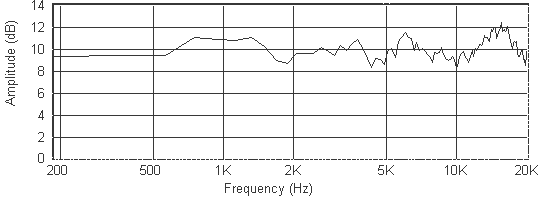 |
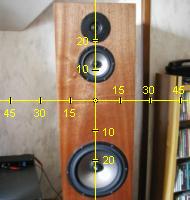 |
Move mouse over the axes on the diagram to the right to see the response at that listening angle.
All measurements taken at 1 meter and referenced to the tweeter height.
Entire project writeup is based on use of faulty tweeters used during crossover design. Go here for details.
Section below is based on impressions with faulty XT19 tweeters installed during evaluation.
Listening Impressions
As the response indicates, these speakers have a very neutral and natural sound to them. If I could only use one word to characterize them
I would have to say detailed. The aluminum drivers have a level of detail that is rarely found with paper or poly cones. These speakers are
highly analytical as well which can be good and bad. They are so revealing that poorly recorded material sounds bad. However, well recorded
material sounds amazing and really makes these babies sing. The imaging is excellent with very precise, pinpoint localization of instruments.
The soundstage is relatively deep with a three dimensional presentation.
I would have to say that the midrange of these speakers is better than anything
I've built so far and is very balanced and open. The bass is deep and tight despite the ported design. These are probably the best sounding
speakers I've built so far but they can be slightly fatiguing due to the amount of detail they have although this is only a problem with poorly recorded
source material. The Asterion design tends to be a little bit easier on your ears but don't have the midrange balance and clarity that the Alpheus do.
A friend of mine who listened to my Alpheus design liked them very much but wasn't 100% satisfied with the Vifa XT19 tweeter. However, he did say
that the Alpheus design is almost as good as his B&W Nautilus 802's and probably better than most of the models below his. He might be
exaggerating but I still take that as a great compliment.
I estimate that a pair of Alpheus speakers will cost about $600 in parts not including finishing supplies (veneer and/or paint). As shown in the
picture with the Sapele veneer they cost around $700. Once again, this is
an incredible value because you won't find anything that sounds this good in the stores anywhere near this cheap. My only curiosity now is
if I could do better with a design based on Dayton RS drivers. I'm pretty sure the RS tweeter would be an improvement but I'm not sure about
the woofer and midrange. Maybe someday I'll find out and you'll see a Dayton RS three way in my projects section but for now I'm going to
sit back and enjoy my Alpheus speakers.
Well I ended up doing that RS three way design that I was thinking about building. There is a review which compares the Alpheus with the
Daedalus (RS 3 way) and the Asterion here.
Speaker Workshop Project File
The Speaker Workshop project file for this design is now available for download: Alpheus.swd. This project
includes gated measurements for all of the drivers and a crossover network simulation. The file is about 2 MB in size so be patient while
downloading if you have a slower connection.
|


